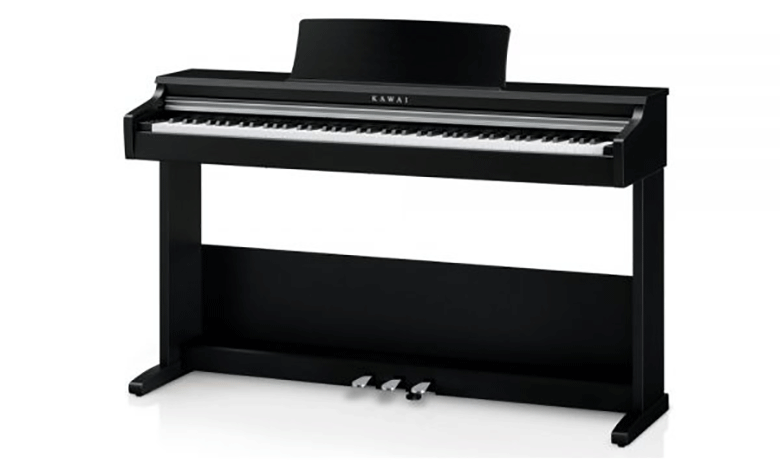Thanks for joining us at Merriam Music. We’ve already done individual reviews of both the Kawai KDP70 digital piano and the more advanced Kawai KDP110. What we haven’t done is a side-by-side comparison of these super-popular Kawai digital pianos. If that’s what you were hoping for, you’ve come to the right place.
KDP70 vs KDP110 | Overview

As members of the famed KDP series, both are big sellers and are considered to be some of the higher-value options available out there. We get a number of customers who come into our showrooms after already having zeroed in on one or the other and the first thing they ask is; “these look similar on paper. Is the KDP110 work the extra money?”
Hopefully, this article and the companion video will help answer that for you.
Let’s start by looking at how these two pianos differ in terms of what they have to offer from a sound perspective. There are some similarities, but there are also some differences. We think you’re certainly getting your money’s worth if you leapfrog the KDP70 and go right to the KDP110.
KDP70 vs KDP110 | Piano Sound Comparison
8-Watt vs 20-Watt Speaker System
On the Kawai KDP70, we have a pair of 8-watt speakers compared to 20-watt x 2 speakers on the KDP110. The difference in the depth of sound and the difference in the overall dynamic range that the KDP120’s speaker system and amplifier provides is pretty substantial, not just in theory, but in the actual playing experience. There’s an extra layer of depth, subtlety, and potential to fill a larger room with the KDP120.
Polyphony
Both pianos have 192 notes worth of polyphony, and the sound engine itself is not that different in that both pianos are using the Harmonic Imaging sound engine with full 88-key sampling. What is different is that the KDP120 features the Shigeru Kawai SK-EX concert grand sample, while the KDP70 just has the Kawai EX concert grand piano sample.
Kawai EX vs Shigeru Kawai SK-EX Grand Sample
While the SKEX sample is more complex, to still get 88-key individual note sampling for what the KDP70 costs is really impressive. And both pianos offer some adjustable reverb settings for tweaking the sound.
Additional Sounds
Aside from the core grand piano sound on each piano, the rest of the sounds are identical with 15 in total. There are 4 acoustic piano patches, and then a mix of electric pianos, organs, and various others including a nice synthesizer sound.
So what we’ve got here is the KDP120 definitely delivers a better sonic experience due to the improved speakers and SKEX sample. But the KDP70 is by no means a slouch and even matches the KDP110 with equal polyphony and 14 of the 15 instrument voices are the same.
KDP70 vs KDP110 | RHC Piano Action

The action on these two pianos is similar, but not the same. Just like with the sound engine where the KDP120 features an upgraded version of the same fundamental engine, the KDP110 features a newer-generation version of the same action used in the KDP70.
The action we’re talking about is of course the authentic Responsive Hammer Compact Keyboard Action.
Kawai KDP70 – Responsive Hammer Compact (RHC)
The Kawai KDP70 actually uses the same version of the RHC that’s used in the Kawai ES110.
Kawai KDP110 – Responsive Hammer Compact II (RHCII)
The difference with the RHCII is that it upgrades the RHC’s single sensor to a triple sensor for a more accurate MIDI output, which has the KDP110.
It also feels like they’ve improved the cushioning on the RHCII as the key bed is closer to the feel of an acoustic piano.
Both actions have a micro-texture on the white and the black keys, and both have some ability to adjust the touch curve.
Both are solid actions, no doubt, but the RHCII being the newer version means it’s definitely providing an all-around better key touch, even if the Roland PHA4 still takes the top spot in the class.
KDP70 vs KDP110 | Features & Connectivity
MIDI and Power Adapter
From a connectivity specs standpoint, the KDP70 does show some limitations with only offering a pair of headphone jacks and traditional 5-pin MIDI in and out. This means if you want to connect to an iPad for apps, you’ll need to buy some form of adapter.
The Kawai KDP110 has all of that, plus USB to Host and Bluetooth MIDI. Of course, both pianos have a DC in for a power adapter.
Lesson Functions
Both pianos have built-in lesson songs and lesson books, such as Alfred, Burgmuller, and Czerny, but the KDP110 has a larger selection and a more robust lesson function.
Typical digital piano technology like a metronome and Four Hands Mode is also available on both.
Cabinet Design
In terms of the cabinet design, it’s similar on both instruments as they both come with a stand, but the KDP110 is a little more robust. Both pianos come with an integrated three-pedal system with half-pedal support and a matching bench at no extra charge.
Finish
The Kawai KDP70 is available in a sleek embossed Black finish, while the KDP120 is available in a more traditional Rosewood finish.
Closing Thoughts

To sum this comparison up, you can essentially think of the KDP70 as an ES110 in cabinet form with three pedals, larger built-in speakers, with a free matching bench. With 192 notes of polyphony, 88-note sampling, 15 presets, and solid action, the KDP70 has a lot to offer.
The Kawai KDP110, for not that much more money, is delivering a class-leading speaker system, superior core piano sound, upgraded action, and a lot more connectivity.
If your budget is maxed already at the KDP70, no worries, this is a great instrument. But if you stretch to the KDP110, for many people, it will be worth it.
Don’t forget to check out our YouTube channel for more reviews!
